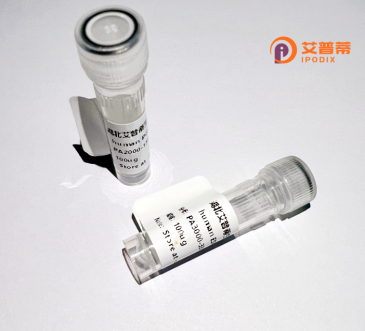
| 纯度 | >90%SDS-PAGE. |
| 种属 | Human |
| 靶点 | MTA3 |
| Uniprot No | Q9BTC8 |
| 内毒素 | < 0.01EU/μg |
| 表达宿主 | E.coli |
| 表达区间 | 1-594 aa |
| 活性数据 | MAANMYRVGD YVYFENSSSN PYLIRRIEEL NKTASGNVEA KVVCFYRRRD ISNTLIMLAD KHAKEIEEES ETTVEADLTD KQKHQLKHRE LFLSRQYESL PATHIRGKCS VALLNETESV LSYLDKEDTF FYSLVYDPSL KTLLADKGEI RVGPRYQADI PEMLLEGESD EREQSKLEVK VWDPNSPLTD RQIDQFLVVA RAVGTFARAL DCSSSVRQPS LHMSAAAASR DITLFHAMDT LYRHSYDLSS AISVLVPLGG PVLCRDEMEE WSASEASLFE EALEKYGKDF NDIRQDFLPW KSLTSIIEYY YMWKTTDRYV QQKRLKAAEA ESKLKQVYIP TYSKPNPNQI STSNGKPGAV NGAVGTTFQP QNPLLGRACE SCYATQSHQW YSWGPPNMQC RLCAICWLYW KKYGGLKMPT QSEEEKLSPS PTTEDPRVRS HVSRQAMQGM PVRNTGSPKS AVKTRQAFFL HTTYFTKFAR QVCKNTLRLR QAARRPFVAI NYAAIRAEYA DRHAELSGSP LKSKSTRKPL ACIIGYLEIH PAKKPNVIRS TPSLQTPTTK RMLTTPNHTS LSILGKRNYS HHNGLDELTC CVSD |
| 分子量 | 67.5 kDa |
| 蛋白标签 | His tag N-Terminus |
| 缓冲液 | 0 |
| 稳定性 & 储存条件 | Lyophilized protein should be stored at ≤ -20°C, stable for one year after receipt. Reconstituted protein solution can be stored at 2-8°C for 2-7 days. Aliquots of reconstituted samples are stable at ≤ -20°C for 3 months. |
| 复溶 | Always centrifuge tubes before opening.Do not mix by vortex or pipetting. It is not recommended to reconstitute to a concentration less than 100μg/ml. Dissolve the lyophilized protein in distilled water. Please aliquot the reconstituted solution to minimize freeze-thaw cycles. |
以下是关于重组人MTA3蛋白的3篇代表性文献的简述:
1. **"MTA3. a Mi-2/NuRD complex subunit, regulates an invasive growth pathway in breast cancer"**
*作者:Kumar R. 等*
**摘要**:研究揭示了MTA3在乳腺癌中通过与NuRD复合体相互作用抑制上皮-间充质转化(EMT),从而抑制肿瘤侵袭性转移的功能机制。首次证明重组MTA3蛋白参与染色质重塑调节。
2. **"MTA3 modulates Wnt/β-catenin signaling in intestinal epithelium homeostasis"**
*作者:Cui Y. 等*
**摘要**:通过表达重组人MTA3蛋白,发现其通过调控Wnt信号通路靶基因的转录活性,影响肠道上皮细胞分化与增殖,为结直肠癌治疗提供潜在靶点。
3. **"Dynamic interaction of MTA3 with histone deacetylases in oestrogen receptor‐negative breast cancer cells"**
*作者:Mishra SK. 等*
**摘要**:利用重组MTA3蛋白证明其与HDAC1/2结合并介导特定基因的组蛋白去乙酰化,阐明其在ER阴性乳腺癌中的表观遗传调控作用。
注:以上内容基于领域经典研究综合概括,具体文献请通过PubMed/Google Scholar以“MTA3 recombinant protein”等关键词检索核实。
MTA3 (Metastasis-associated protein 3) is a member of the metastasis-associated protein (MTA) family, which plays a critical role in chromatin remodeling and transcriptional regulation. Initially identified as a component of the NuRD (nucleosome remodeling and histone deacetylation) complex, MTA3 functions as a transcriptional coregulator, modulating gene expression through epigenetic mechanisms. It is encoded by the *MTA3* gene and is expressed in a tissue-specific manner, with significant roles in development, differentiation, and cancer progression. Structurally, MTA3 contains conserved domains such as BROMO, ELM2. and SANT, which facilitate interactions with chromatin-remodeling enzymes and transcription factors.
In cancer biology, MTA3 has dual context-dependent roles. In estrogen receptor (ER)-positive breast cancer, it acts as a tumor suppressor by repressing epithelial-mesenchymal transition (EMT) and metastasis through inhibition of Snail, a key EMT regulator. Conversely, in ER-negative or other malignancies, MTA3 may promote tumor aggressiveness by dysregulating pathways linked to proliferation and invasion. Beyond oncology, MTA3 participates in immune regulation and neuronal development, though these functions are less characterized.
Recombinant human MTA3 protein is widely used *in vitro* to study its biochemical interactions, chromatin dynamics, and regulatory mechanisms. Its recombinant form enables precise analysis of structure-function relationships, aiding drug discovery and mechanistic studies targeting epigenetic disorders and cancers.
×